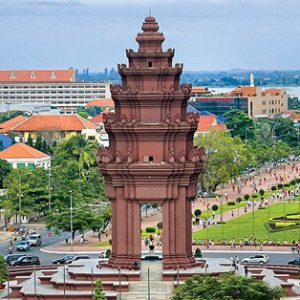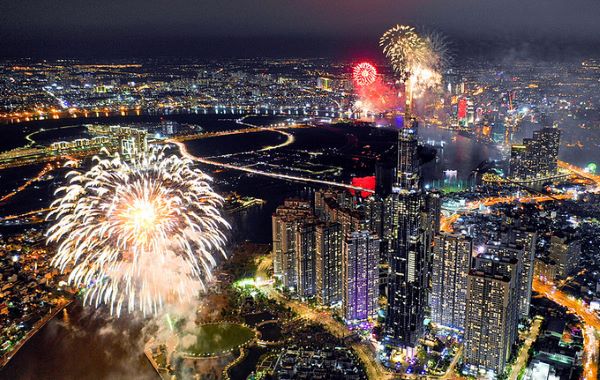Phnom Penh, the capital of Cambodia, is a city where history, culture and modern life intertwine to create an unforgettable experience.
Why visit Phnom Penh? This historic city allows travelers to delve into Cambodia’s heritage while discovering its emerging urban scene. If you’re considering travel to Cambodia, here are the top reasons why Phnom Penh should be on your itinerary.
1. A profound historical experience
For those seeking a deeper understanding of Cambodia’s tragic yet resilient past, Phnom Penh is an unparalleled destination. The Khmer Rouge regime left a devastating mark on the country and nowhere is that more apparent than in Phnom Penh. Phnom Penh’s historical significance is deeply intertwined with Cambodia’s cultural heritage.
The Tuol Sleng Genocide Museum and the Killing Fields of Choeung Ek offer an emotional look into one of the darkest periods of modern history. Tuol Sleng, a former high school turned into a detention and torture center during the Khmer Rouge era, now serves as a museum to educate visitors about the atrocities committed. Despite the heavy subject matter, they are essential for understanding Cambodia’s recent history and the resilience of its people.
2. Stunning royal complex
The Royal Palace stands as a symbol of the Cambodian monarchy. This grand complex, still home to Cambodia’s King, features some of the most exquisite Khmer architecture. The palace is a breathtaking fusion of glittering golden buildings, ornate carvings, and lush gardens. Visitors can explore the palace grounds and marvel at its golden spires and intricately decorated halls.
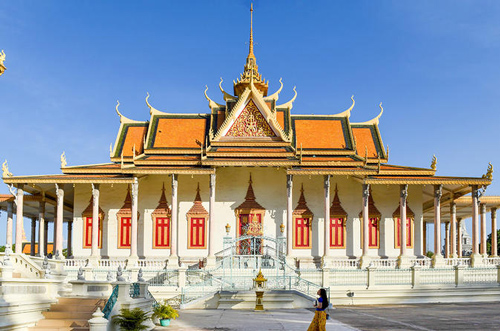
The Royal Palace in Phnom Penh
Inside the palace complex lies the Silver Pagoda, famous for its glittering floor made up of 5000 silver tiles. The pagoda is home to Cambodia’s most sacred Buddhist statues, including a life-sized golden Buddha encrusted with diamonds.
3. Tranquil temples
Phnom Penh’s deep connection to Buddhism is evident in the number of temples scattered throughout the city. Visiting a Buddhist temple (known as a wat) is a must for anyone interested in spirituality or local culture. These temples are centers of community life, where locals pray, make offerings, and celebrate religious festivals. As you explore the city, you’ll find wats of all sizes, from the iconic Wat Phnom—which gives the city its name—to smaller, lesser-known temples hidden in the backstreets.
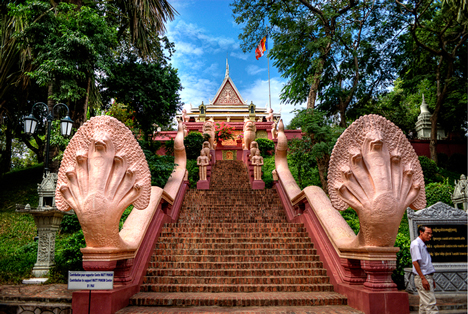
Wat Phnom Temple in Phnom Penh
4. Local markets experience
Why visit Phnom Penh? Phnom Penh’s bustling markets are a treat for those who love shopping and experiencing local life.
The Central Market (Psar Thmei), built in an Art Deco style, is one of Phnom Penh’s most recognizable buildings. The massive yellow dome houses vendors selling everything from jewelry to fresh produce, and it’s a bustling hub of local commerce. This retro marketplace is a must-visit for architecture enthusiasts and bargain hunters alike.
For a more intimate shopping experience, visit the Russian Market (Psar Toul Tom Poung). This maze-like market is famous for its handmade crafts, textiles, and antiques, making it an ideal spot for finding unique treasures to take home.
Strolling through these markets allows travelers to engage with local vendors, try authentic Cambodian street food, and experience daily life in Phnom Penh.
5. Flourishing modern culture
Phnom Penh is a hub for Cambodia’s modern cultural revival. A growing number of art galleries, studios, and cultural spaces have sprung up across the city, showcasing works by established and up-and-coming Cambodian artists. These galleries are wonderful places to explore if you’re interested in the creative side of Cambodia.
Coupled with this artistic renaissance is the rise of trendy cafés and restaurants. From cool coffee shops to chic eateries, Phnom Penh’s café culture has taken off, making it a great place for foodies and coffee lovers. You can easily spend an afternoon sipping local brews while appreciating the city’s laid-back atmosphere.
6. A city of contrasts and change
Phnom Penh is a city of contrasts, where old meets new at every turn. While its historical sites offer a glimpse into its turbulent past, its modern developments and emerging creative industries are a testament to Cambodia’s fast-paced growth. As Cambodia modernizes, Phnom Penh is leading the charge with new infrastructure projects, international businesses, and a youthful, entrepreneurial energy.
Yet, the city has retained much of its charm. The French colonial architecture that lines the streets, combined with the traditional Khmer buildings and temples, creates a unique visual identity for Phnom Penh. As you walk through the streets, you will see how the city has evolved while still honoring its past.
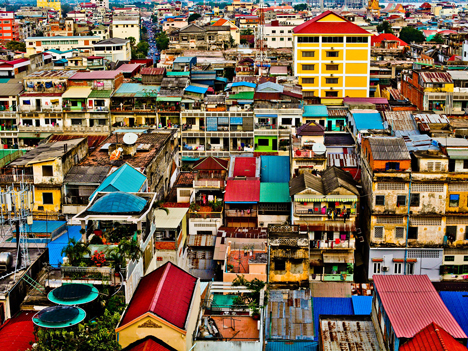
Phnom Penh From Above
Tips for visiting Phnom Penh
Best time to visit Phnom Penh
The best time to visit Phnom Penh is during the dry season from November to February. During these months, the weather is more temperate, making it ideal for sightseeing and outdoor activities. Temperatures are cooler and the humidity is lower, which will make your time exploring the city much more comfortable. However, as this is the peak tourist season, expect popular attractions to be more crowded and accommodation rates might be higher. If you’re looking to avoid crowds, consider visiting during the shoulder seasons of October or March.
How to get there?
Phnom Penh is well connected by air, with the Phnom Penh International Airport (PNH) serving as the main entry point for international travelers. There are direct flights to Phnom Penh from major cities in Southeast Asia and some international hubs, making it easily accessible. Bus routes are also available from neighboring countries if you’re on a Vietnam tour or a Thailand tour
Once you arrive in the city, tuk-tuks are the most popular way to get around. For convenience and price transparency, you can also use ride-booking apps like Grab or simply rent a private car with driver in Cambodia.
What to eat in Phnom Penh?
Traditional Cambodian dishes are fresh, fragrant, and often influenced by neighboring Thailand and Vietnam, but with their own unique Khmer twist.
- Amok: a creamy coconut fish curry that is steamed in banana leaves and flavored with lemongrass, kaffir lime, and galangal.
- Nom banh chok: a type of noodle dish typically eaten for breakfast topped with green fish curry and fresh vegetables.
For international cuisine, Phnom Penh has no shortage of options. French bakeries, Indian curries, and Italian pasta all find a place on Phnom Penh’s ever-expanding culinary map.
Why visit Phnom Penh? More than just the capital of Cambodia—it’s a city of contrasts, where the past and present coexist in a unique blend. Whether you’re drawn to its grand palaces, haunting historical sites, lively markets, or emerging art scene, Phnom Penh offers a rich experience that should not be missed.
If you’re looking for a destination that combines culture, history, and modern vibrancy with a laid-back feel, Phnom Penh is a perfect choice. Start planning your Cambodia travel today and discover one of Southeast Asia’s hidden gems.

